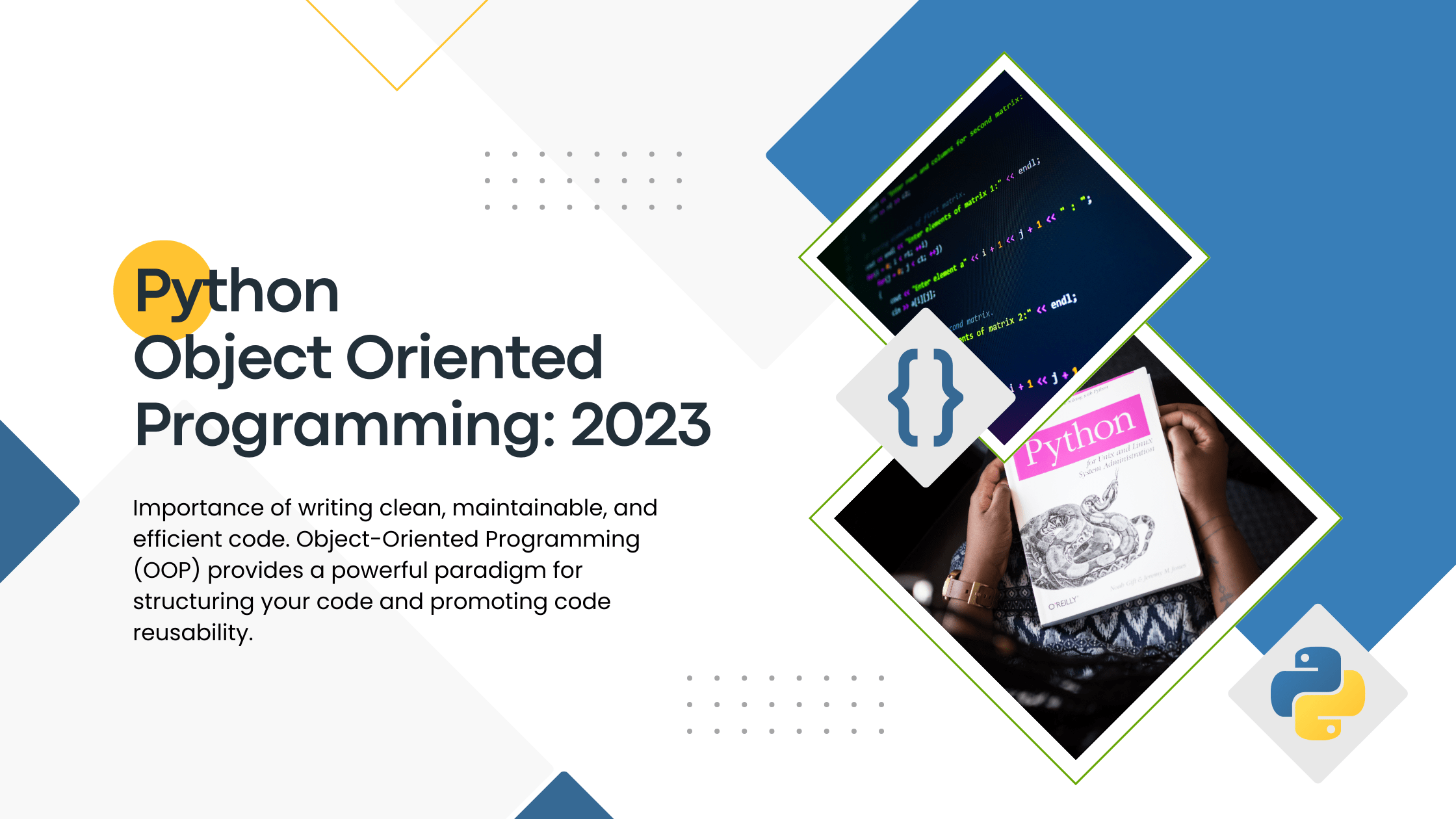Python developers understand the importance of writing clean, maintainable, and efficient code. Object-Oriented Programming (OOP) provides a powerful paradigm for structuring your code and promoting code reusability.
In this article, we will explore the best practices for Python OOP that every expert Python developer should know. From understanding the different types of methods to optimizing your code for performance, we will cover it all.
Introduction to Python OOP
As a software developer, you are already familiar with the basics of OOPs. However, it’s important to have a solid understanding of the core concepts before diving into best practices.
Object-oriented programming revolves around the idea of organizing code into objects, which are instances of classes. An object consists of both data, represented by attributes, and behavior, represented by methods. This encapsulation of data and behavior allows for better code organization, reusability, and modularity.
Python provides full support for OOP, making it an ideal language for building complex applications. With its intuitive syntax and extensive standard library, Python allows you to write clean and concise code, leveraging the power of OOP.
The Three Types of Methods in Python
Methods are an integral part of Python classes and define the behavior of objects. In Python, there are three types of methods: instance methods, class methods, and static methods. Understanding the differences between these types of methods is essential for writing effective and efficient code.
1. Instance Methods
Instance methods are the most common type of methods in Python. They are defined within a class and operate on individual instances (objects) of that class. Instance methods have access to the instance’s attributes and can modify them.
class Car:
def __init__(self, brand, model):
self.brand = brand
self.model = model
def start_engine(self):
print(f"The {self.brand} {self.model} is starting the engine.")
my_car = Car("Toyota", "Camry")
my_car.start_engine()
In the above example, start_engine() is an instance method that operates on a specific instance of the Car class. It accesses the instance’s attributes (self.brand and self.model) and performs an action specific to that instance.
2. Class Methods
Class methods are methods that operate on the class itself rather than on instances of the class. They are defined using the @classmethod decorator and have access to the class’s attributes and methods.
class Car:
total_cars = 0
def __init__(self, brand, model):
self.brand = brand
self.model = model
Car.total_cars += 1
@classmethod
def display_total_cars(cls):
print(f"There are {cls.total_cars} cars.")
Car.display_total_cars()
In the above example, display_total_cars() is a class method that accesses the class attribute total_cars. It can be called on the class itself, without requiring an instance of the class.
3. Static Methods
Static methods are methods that do not operate on instances or the class itself. They are defined using the @staticmethod decorator and are mainly used for utility functions that are related to the class but do not require access to class or instance attributes.
class MathUtils:
@staticmethod
def add_numbers(a, b):
return a + b
result = MathUtils.add_numbers(2, 3)
print(result) # Output: 5
In the above example, add_numbers() is a static method that performs a simple addition operation. It does not require access to any instance or class attributes and can be called directly on the class itself.
Understanding the differences between these types of methods allows you to leverage their strengths and write more efficient and modular code.
When to Use Instance Methods
Instance methods are the most commonly used type of method in Python OOP. They operate on individual instances (objects) of a class and have access to the instance’s attributes. Instance methods are used to encapsulate behavior that is specific to each instance.
When writing Python classes, it is important to identify the behavior that is specific to each instance and encapsulate it within instance methods. This allows for better code organization and promotes the principle of encapsulation.
Let’s consider an example of a Car class:
class Car:
def __init__(self, make, model):
self.make = make
self.model = model
self.mileage = 0
def drive(self, distance):
self.mileage += distance
print(f"Drive {distance} miles. Total mileage: {self.mileage} miles")
# Example of using instance methods
my_car = Car("Toyota", "Camry")
my_car.drive(50)
my_car.drive(30)
In this example, the drive method is an instance method because it operates on an instance of the Car class (my_car). It updates the mileage attribute based on the distance driven.
By using instance methods, you can encapsulate behavior that is specific to each instance, making your code more modular and maintainable.
Leveraging Class Methods for Code Reusability
Class methods are a powerful tool for code reusability in Python OOP. They operate on the class itself rather than on instances of the class. Class methods have access to the class’s attributes and methods, allowing them to perform actions that are related to the class as a whole.
One common use case for class methods is when you need to create alternative constructors for your class. By defining a class method that serves as an alternative constructor, you can provide different ways of creating instances of your class.
Let’s consider an example of a MathOperations class:
class MathOperations:
@classmethod
def add(cls, num1, num2):
return f"The sum is: {num1 + num2}"
@classmethod
def multiply(cls, num1, num2):
return f"The product is: {num1 * num2}"
# Example of using class methods for code reusability
result_addition = MathOperations.add(5, 3)
result_multiplication = MathOperations.multiply(5, 3)
print(result_addition)
print(result_multiplication)
In this example, add and multiply are class methods of the MathOperations class. They don’t operate on instances of the class but are available on the class itself. This allows for code reusability without the need to create an instance of the class.
By leveraging class methods, you can provide alternative ways of creating instances of your class, making your code more flexible and reusable.
The Power of Static Methods in Python
Static methods are another valuable tool in Python OOP. Unlike instance methods and class methods, static methods do not operate on instances or the class itself. Instead, they are mainly used for utility functions that are related to the class but do not require access to class or instance attributes.
Static methods are defined using the @staticmethod decorator and can be called directly on the class itself, without requiring an instance. They do not have access to self or cls parameters.
Let’s consider an example of a Calculator class:
class Calculator:
@staticmethod
def square(number):
return f"The square of {number} is: {number ** 2}"
@staticmethod
def cube(number):
return f"The cube of {number} is: {number ** 3}"
# Example of using static methods for simplicity
result_square = Calculator.square(4)
result_cube = Calculator.cube(3)
print(result_square)
print(result_cube)
In this example, square and cube are static methods of the Calculator class. They don’t have access to the instance or class itself but are defined within the class for organizational purposes. Static methods are useful when a method doesn’t depend on the class state and doesn’t modify it. They provide simplicity and clarity in code.
Static methods are useful for encapsulating utility functions that are related to a class but do not require access to class or instance attributes. They promote code organization and modularity by grouping related functions together.
Examples of Code Reusability and Optimization
As an expert Python developer, you understand the importance of reusing code and optimizing performance. Let’s explore some real-world examples of how you can achieve code reusability and optimize your Python OOP applications.
Example 1: Reusing Code with Inheritance
Inheritance is a powerful feature in Python OOP that allows you to create a new class (child class) based on an existing class (parent class). By inheriting from a parent class, the child class inherits all the attributes and methods of the parent class, making it easy to reuse code.
Consider the following example:
class Shape:
def __init__(self, color):
self.color = color
def area(self):
raise NotImplementedError("Subclasses must implement this method.")
def perimeter(self):
raise NotImplementedError("Subclasses must implement this method.")
class Rectangle(Shape):
def __init__(self, color, width, height):
super().__init__(color)
self.width = width
self.height = height
def area(self):
return self.width * self.height
def perimeter(self):
return 2 * (self.width + self.height)
In the above example, the Shape class defines common attributes and methods for shapes. The Rectangle class inherits from the Shape class and provides specific implementations for the area() and perimeter() methods.
By using inheritance, you can reuse code from the parent class (Shape) in the child class (Rectangle), reducing code duplication and promoting code reusability.
Example 2: Optimizing Performance with Memoization
Memoization is a technique used to optimize the performance of functions by caching the results of expensive function calls. By storing the results of function calls in a cache, subsequent calls with the same arguments can be quickly retrieved from the cache, avoiding redundant calculations.
Consider the following example:
class Fibonacci:
cache = {}
@staticmethod
def calculate(n):
if n in Fibonacci.cache:
return Fibonacci.cache[n]
if n <= 2:
result = 1
else:
result = Fibonacci.calculate(n - 1) + Fibonacci.calculate(n - 2)
Fibonacci.cache[n] = result
return result
In the above example, the Fibonacci class provides a static method calculate() that calculates the nth Fibonacci number. The results of previous calculations are stored in the cache dictionary to avoid redundant calculations.
By using memoization, you can significantly improve the performance of expensive calculations, such as recursive functions, by reusing previously calculated results.
These examples demonstrate how you can leverage code reusability and optimization strategies in Python OOP to create efficient and maintainable applications.
Best Practices for Writing Clean and Maintainable Code
Writing clean and maintainable code is crucial for long-term success as a Python developer. By following a set of best practices, you can ensure that your code is easy to understand, modify, and maintain. Let’s explore some of these best practices:
1. Single Responsibility Principle
The Single Responsibility Principle states that a class should have only one reason to change. In other words, a class should have a single responsibility or purpose. This principle promotes code organization and modularity by keeping classes focused on specific tasks.
When designing your classes, strive for high cohesion and low coupling. Each class should encapsulate a specific behavior or functionality and should not have unnecessary dependencies on other classes.
2. Keep Your Classes Small
Favor small classes over god classes. Large classes that try to do too much can be difficult to understand, modify, and test. Instead, break down complex functionality into smaller, more focused classes.
Divide your code into logical units, each responsible for a specific task or functionality. This makes your code more modular and easier to maintain.
3. Use Meaningful Names
Choosing meaningful and descriptive names for classes, attributes, and methods is essential for code readability. Use names that accurately describe the purpose and functionality of each component.
Avoid generic names like data, value, or result. Instead, choose names that provide context and convey the intent of the code.
4. Encapsulation and Data Hiding
Encapsulation is a fundamental principle of OOP that promotes data hiding and information hiding. By encapsulating data and behavior within classes, you can control access to class attributes and methods, preventing unauthorized modifications or access.
Use access modifiers, such as public, private, and protected, to control the visibility and accessibility of class members. This allows you to enforce proper usage of your classes and safeguard sensitive data.
5. Documentation with Docstrings
Documenting your code using docstrings provides valuable information to users and other developers. Docstrings describe the purpose, functionality, and usage of classes, attributes, and methods.
Use descriptive and informative docstrings that follow a consistent format, such as the Google-style docstring format. This makes your code more understandable and promotes code reuse.
6. Following PEP 8 Guidelines
PEP 8 is the official style guide for Python code. Following the guidelines outlined in PEP 8 promotes code consistency and readability across projects.
Ensure that each line of code is limited to 80 characters, import libraries at the beginning of your code, and eliminate redundant or intermediary variables. Adhering to PEP 8 guidelines makes your code more professional and maintainable.
7. Unit Testing for Robust Code
Unit testing is a crucial aspect of software development. By writing tests for your classes and methods, you can ensure that your code behaves as expected and catches any potential bugs or issues.
Use a testing framework, such as unittest or pytest, to write comprehensive tests that cover different scenarios and edge cases. Regularly run your tests to verify the correctness of your code and catch any regressions.
By following these best practices, you can write clean, maintainable, and robust code that is easier to understand, modify, and maintain.
Common Pitfalls to Avoid in Python OOP 🛟
While Python OOP provides powerful tools and concepts for writing clean and efficient code, there are also some common pitfalls to be aware of. By avoiding these pitfalls, you can write code that is more robust and maintainable.
1. Overusing Inheritance
Inheritance should be used judiciously and only when it makes sense from a design perspective. Overusing inheritance can lead to code that is difficult to understand, maintain, and test.
Instead of relying heavily on inheritance, consider using composition and interfaces to achieve code reusability and modularity.
2. Creating Complex Hierarchies
Creating overly complex class hierarchies can make your code difficult to understand and modify. Aim for a flat and simple class hierarchy that is easy to reason about.
If you find that your class hierarchy is becoming too complex, consider refactoring your code to simplify it and make it more maintainable.
3. Violating the Single Responsibility Principle
The Single Responsibility Principle states that a class should have only one reason to change. Violating this principle can lead to code that is difficult to understand, modify, and test.
When designing your classes, strive for high cohesion and low coupling. Each class should have a single responsibility and should not have unnecessary dependencies on other classes.
4. Neglecting Documentation and Testing
Documentation and testing are crucial aspects of software development. Neglecting to document your code or write tests can lead to code that is difficult to understand, modify, and maintain.
Ensure that you provide clear and informative docstrings for your classes, attributes, and methods. Write comprehensive tests that cover different scenarios and edge cases to verify the correctness of your code.
By avoiding these common pitfalls, you can write code that is more robust, maintainable, and efficient.
Conclusion
As a software developer, understanding and applying best practices for Python OOP is essential for writing clean, maintainable, and efficient code. From leveraging different types of methods to optimizing performance and avoiding common pitfalls, following these best practices will help you become a better Python developer.
By following best practices for writing clean and maintainable code, you can ensure that your code is easy to understand, modify, and maintain. By employing performance optimization strategies and avoiding common pitfalls, you can write code that is robust, efficient, and scalable.
So, as a curious Python developer, embrace these best practices, continuously expand your knowledge, and strive to write code that is of the highest quality. By doing so, you will become a valuable asset in the Python development community and set yourself apart as a skilled Python developer.
Keep coding, keep learning, and keep pushing the boundaries of what you can achieve as a Python developer!






